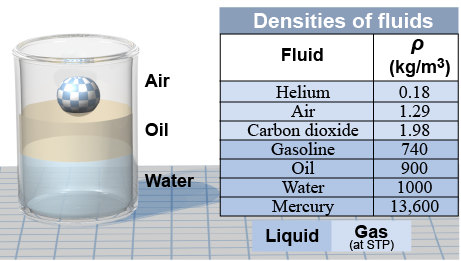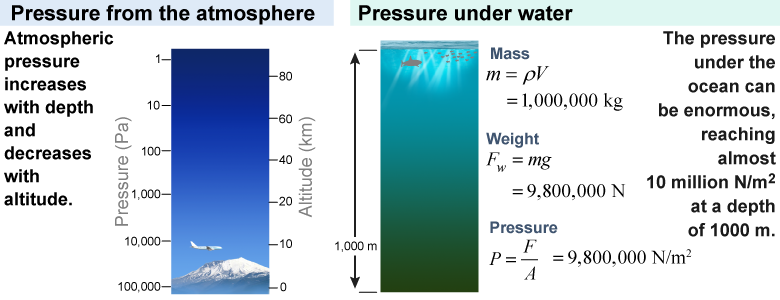|
 The density of a fluid is the ratio of the mass divided by the volume, as shown in equation (23.10). Air has a density of 1.29 kg/m3 at standard temperature and pressure (STP, which means atmospheric pressure and a temperature of 0ºC). The density of gases changes rapidly with temperature and pressure. Water has a density of 1,000 kg/m3. Mercury (metal) is liquid at room temperature and has a density of 13,580 kg/m3!
The density of a fluid is the ratio of the mass divided by the volume, as shown in equation (23.10). Air has a density of 1.29 kg/m3 at standard temperature and pressure (STP, which means atmospheric pressure and a temperature of 0ºC). The density of gases changes rapidly with temperature and pressure. Water has a density of 1,000 kg/m3. Mercury (metal) is liquid at room temperature and has a density of 13,580 kg/m3! 
|
| (23.10) | | | ρ | = | density (kg/m3) | | m | = | mass (kg) | | V | = | volume (m3) |
| Density
|
|
Because fluids can flow, an object or another fluid may either sink or float when resting on a second fluid. An object of lower average density than a fluid is buoyant and floats on that fluid. An object of higher average density sinks. Oil has a lower density than water; therefore, oil floats on water. A ping-pong ball has a lower average density than either water or oil because its interior is filled with air. A ping-pong ball therefore floats above both oil and water. 
|
The weight of a fluid creates hydrostatic pressure. Hydrostatic pressure increases with depth under water. At any given depth d, the pressure P in newtons per square meter equals the weight of a square meter column reaching all the way back up to the surface. This weight depends on the density of the fluid ρ and the acceleration due to gravity g, as seen in equation (23.11). Denser fluids (such as water) create more pressure at a given depth when compared to lighter fluids such as air. Even air at its low density of ρ = 1.29 kg/m3 creates a pressure of more than 100,000 Pa because of the nearly 100 km height of the Earth’s atmosphere. 
|
| (23.11) | | | P | = | pressure (Pa or N/m2) | | ρ | = | density (kg/m3) | | g | = | acceleration of gravity | | | = | 9.8 N/kg at Earth’s surface | | d | = | depth (m) |
| Hydrostatic
pressure
|
|

|
Approximately how deep underwater do you have to go before the gauge pressure is 10 times the pressure of the atmosphere? Assume the atmosphere has a pressure of 101,325 Pa. - 1.01 m
- 10.3 m
- 103 m
- 1,010 m
 |
Answer c is correct, 103 m. Set the hydrostatic pressure ρgh equal to 10 times the pressure of one atmosphere Patm: As you dive deeper into water, the hydrostatic pressure increases rapidly because water is so dense!
The question refers to gauge pressure, so we are considering the hydrostatic pressure resulting from the water—and not the additional pressure from the atmosphere above the water (which would be included if we were calculating the absolute pressure). 
|

